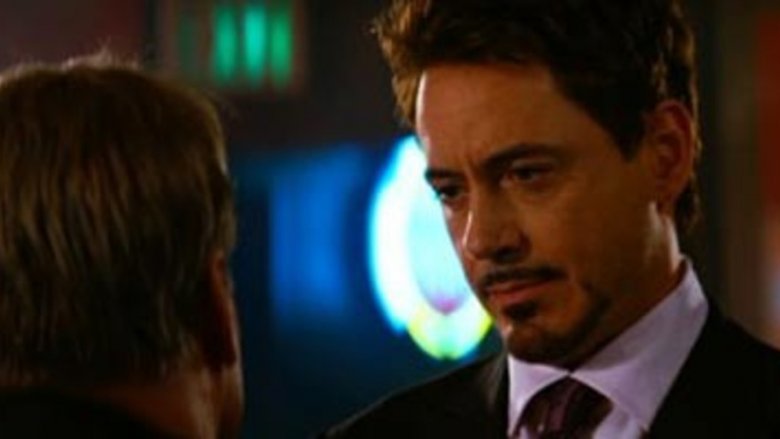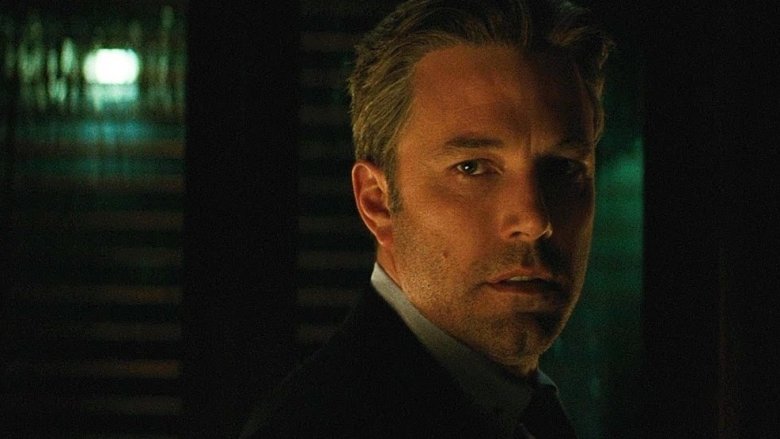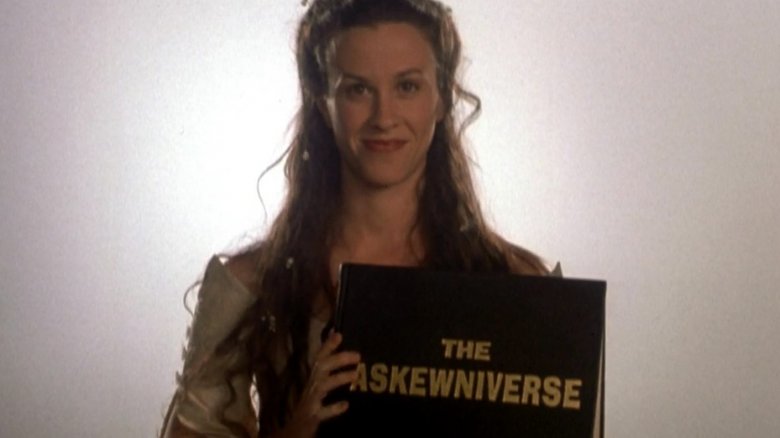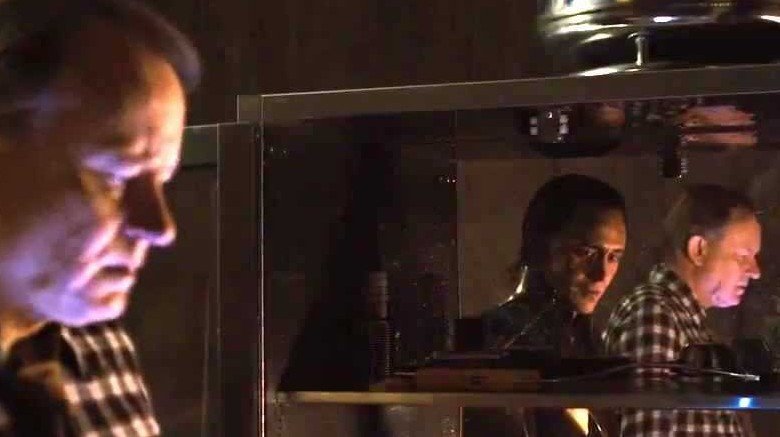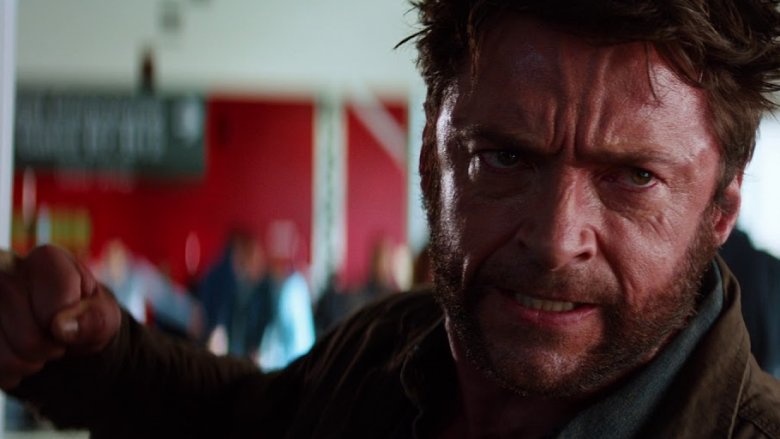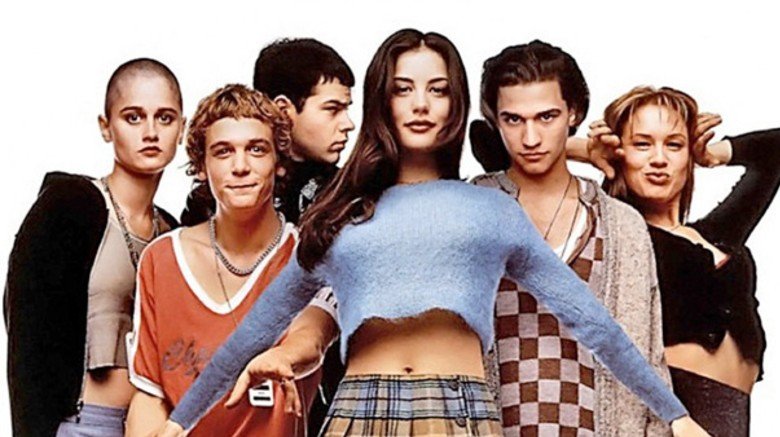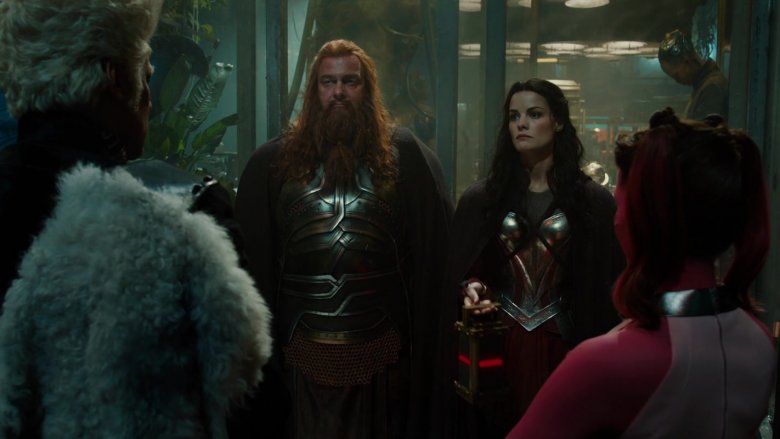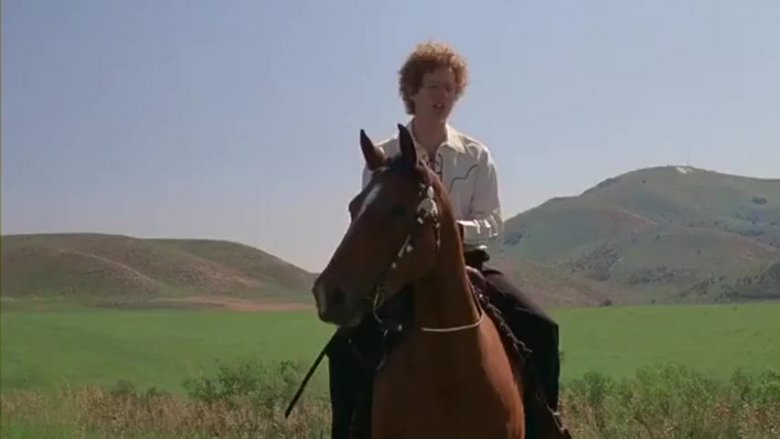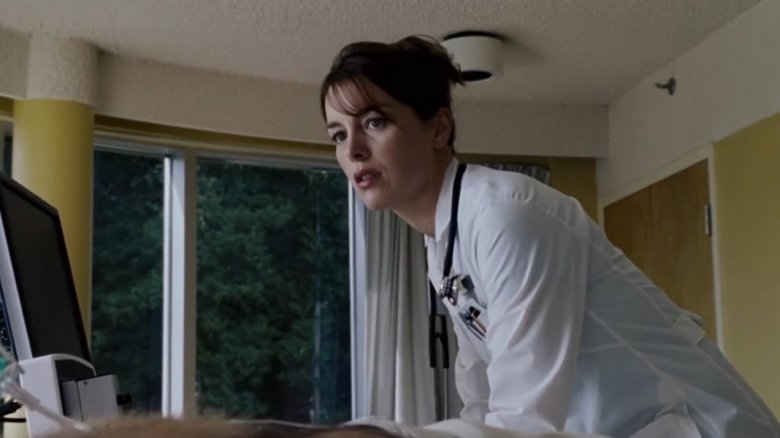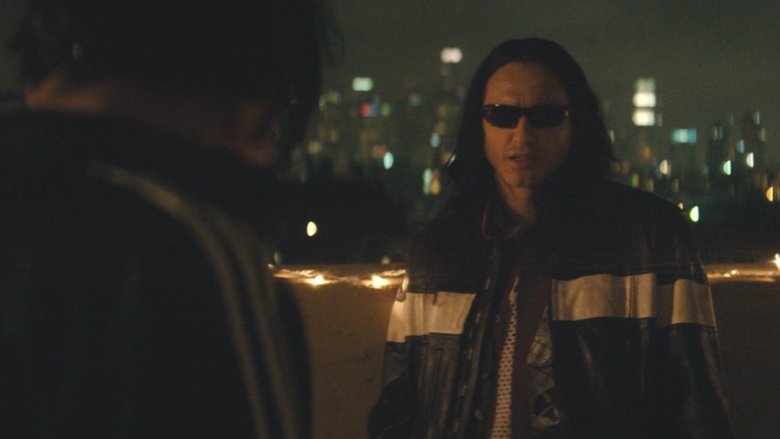Post-Credits Scenes That Made Absolutely No Sense
The popularity of Marvel Studios' superhero blockbusters has helped to make post-credits scenes a much more common event at the theater. It's gotten to the point where they seem almost mandatory for superhero films, Marvel or otherwise. Moviegoers check the web before heading to the theater to find out whether or not they should bother waiting through the credits, and those who do wait look at the people who get up and leave like they're nuts.
Not all post-credits scenes are created equal. Some are just confusing, particularly in sprawling and ambitious narratives like the MCU. Filmmakers might use post-credits scenes to tease the audience about future films, but then apparently plans change and when you go back to watch the earlier film, that post-credits scene you found so entertaining and clever no longer makes sense. Other times, the filmmakers just don't seem to take as much care with these scenes, and the moments are duds that hardly seem worth waiting for. If you can't remember any examples, here are some of the post-credits scenes we're talking about — the ones that make absolutely no sense.
The Consultant
Technically, 2008's The Incredible Hulk doesn't have a post or even a mid-credits scene. The exchange between General Ross (William Hurt) and Tony Stark (Robert Downey, Jr.) happens right before the credits, but it serves the same purpose as so many post-credit scenes. Had Hulk not come so early in the MCU, before the formula was perfected, the scene certainly would've been moved back a few minutes.
As the general drowns his sorrows in the aftermath of the movie's final Hulk/Abomination battle, Stark enters to tell him about a team that's being put together that could help Ross with his "problem." The implication is that Stark is offering to use the Avengers to hunt the Hulk. But the Avengers never hunt the Hulk. And in the MCU's next film, 2010's Iron Man 2, Nick Fury (Samuel L. Jackson) tells Stark that S.H.I.E.L.D. no longer wants him on the the Avengers, except as a consultant. So how does it make sense that a guy who isn't even an Avenger goes to Ross to pitch the idea of a team he's not on hunting down the Hulk?
It doesn't. Clearly, plans changed at Marvel Studios. In 2011, the short film "The Consultant" was released on the Thor Blu-ray, apparently to force the problematic scene into making sense. "The Consultant" reveals that the World Security Council has ordered Agent Coulson (Clark Gregg) to get the Abomination, a.k.a. Emil Blonsky (Tim Roth), from Ross so they can recruit him for the Avengers. Coulson sends Stark to make the request, knowing Stark will annoy Ross... hopefully enough to make Ross say no. The plan works, and we learn that to spite Ross, Stark has bought the general's favorite bar and had it demolished.
Threats at dinner
Batman (Ben Affleck) is surprisingly important to 2016's Suicide Squad. We learn in flashbacks he's responsible for the captures of Deadshot (Will Smith) and Harley Quinn (Margot Robbie), setting them up for recruitment onto Amanda Waller's (Viola Davis) team of leashed villains.
In a mid-credits scene, Waller and Bruce Wayne have dinner together. Waller gives Wayne files on metahumans and in return he offers his protection against any reprisals she might face for the events of Suicide Squad. Before he leaves, Waller tells Wayne he should "stop working nights," implying she knows he's Batman. Wayne tells Waller "You should shut it down, or my friends and I will do it for you." By "it" he apparently means the Suicide Squad.
There are a few things in this scene that make no sense. First, there's Wayne's offer of protection. Batman might be able to protect Waller against the Riddler, but how is he supposed to protect her job and her freedom if the events of Midway City come to light? Second, there's Waller's veiled threat. Batman captures at least two of Waller's Squad members, maybe more. If Wayne "stopped working nights," she'd probably run out of recruits. Third and finally, it doesn't make sense for Wayne to threaten Waller. She knows he's Batman, at this point there is no Justice League to help carry out his threat, and Wayne seems the type who'd rather keep his mouth shut and just take care of it rather than beat his chest.
Closing the book
In 2001, writer/director Kevin Smith marked the end of his so-called "Askewniverse" with the comedy Jay and Silent Bob Strike Back. Named after his production company View Askew, the Askewniverse included 1994's Clerks, 1995's Mallrats, 1997's Chasing Amy, and 1999's Dogma. Smith appears in all of the films as stoner Silent Bob, alongside real life buddy Jason Mewes as the much more talkative Jay. The pair's appearances were relatively brief in most of the other Askewniverse flicks, so Smith chose to end that narrative by giving the pair their own chance to shine in Jay and Silent Bob Strike Back.
A brief post-credits scene waits at the end of the flick, featuring singer-songwriter Alanis Morissette. Morissette famously appeared as God in Smith's religious satire Dogma. After the credits roll at the end of Strike Back, she can be seen holding an open book that reads "THE END." She closes the book, and we see the title The Askewniverse, suggesting that Smith is forever closing the book on this narrative.
Except... he comes back. Five years after Alanis closed that book, Clerks II was released. There's also a Jay and Silent Bob reboot (literally titled Jay and Silent Bob Reboot) due later in 2019. So, Jay and Silent Bob Strike Back's post-credits scene no longer makes sense. But that doesn't make it much different from the rest of the movie (it really isn't meant to make sense), so that's okay.
Worth a look
At the end of 2011's Thor, Dr. Erik Selvig (Stellan Skarsgård) meets with Nick Fury in one of S.H.I.E.L.D.'s secret facilities. Fury shows Selvig the powerful Tesseract, hoping to recruit the doctor to help unlock the cube's secrets. When the camera reveals a mirror on the wall next to Selvig, we see Loki (Tom Hiddleston) walk into the reflection, seeming to be looking down at the Tesseract just like Selvig. Loki turns to Selvig and whispers "Well I guess that's worth a look." Selvig smiles, looks at Fury, and repeats the exact same phrase.
The scene implies either that Loki has mental influence over the scientist or that Selvig is Loki in disguise. Since the release of Avengers, we know neither scenario makes sense. Loki does eventually take over Selvig's will, but that isn't until the events of Avengers, and he needs the scepter containing the Mind Stone to do it. Nor could he be Loki in disguise. We know that after his defeat in Thor Loki makes an ally of Thanos, and his goal is to use the Tesseract's power to transport the Mad Titan's armies to Earth. It isn't as if he could easily go back and forth from Earth to wherever Thanos is.
The recruit
In order to tease the following year's X-Men: Days of Future Past, 2013's The Wolverine features a post-credits scene that takes place two years after the conclusion of the film.
Logan is at an airport security checkpoint when the shaking of metal objects alerts him to the presence of Magneto (Ian McKellen). Magneto freezes Logan before the hero can strike him. He warns Logan of "dark forces" building a weapon to hurt mutants and tells Logan he wants the hero's help. When everyone else in the airport turns into frozen statues, Professor X (Patrick Stewart) — who Logan watched die in 2006's X-Men: The Last Stand — reveals himself.
The scene stopped making sense upon Days of Future Past's release. While we're led to believe this scene will lead directly into Days of Future Past, that film opens in the year 2023. The post credits scene is set in 2015, making an eight year gap between the events we're being shown. Maybe there was a communication breakdown, or maybe plans changed, but the discrepancy is never explained.
Regardless of the time jump, the logic of the scene also fails in terms of Magneto's reveal. Not only is this the only time we've seen metal objects reacting to Magneto's presence even when he's not trying to mess with them, but for some reason Wolverine is the only one in the crowded airport who notices.
Debating bass lines
The 1995 cult hit Empire Records doesn't have a post-credits scene so much as a plain old credits scene. The credits roll over Mark (Ethan Embry) and Eddie (James "Kimo" Wills) sitting on the curb and debating the merits of Henry Rollins, Primus, and what makes a great punk rock band. They're so involved in their discussion that when a car speeds by and crashes into something, the two don't even notice and just keep talking.
First, there's the obvious car crash. While the scene is trying to make the point that these two characters are so passionate about music that nothing can tear them away from their discussion, the whole thing just doesn't seem believable and comes off as contrived. It would be more convincing if the pair noticed the crash, said nothing about it, and then just kept talking.
But there's also what these two supposed punk rock historians are discussing. While their mentions of the Misfits and the Pixies make sense, their conversation starts with the pair trashing Henry Rollins. And they apparently think Primus is a punk band? Mitch McConnell has more punk rock cred than these two morons.
One down
The mid-credits scene of 2013's Thor: The Dark World is one of the most deceptively important moments of the Marvel Cinematic Universe. Not only does it tease the following year's blockbuster Guardians of the Galaxy, it's the first time in the MCU that the Infinity Stones are mentioned by name. Unfortunately, the premise of the scene is flawed.
Volstagg (Ray Stevenson) and Sif (Jaimie Alexander) arrive in Knowhere to present the Collector (Benicio Del Toro) with the Aether. When the Collector asks the Asgardians why they've brought the Aether there rather than keeping it on Asgard, Volstagg answers that the Tesseract is already in Odin's Vault and it would be a bad idea to keep more than one Infinity Stone in the same place.
This scene would make plenty of sense if it weren't for the fact that Odin (Anthony Hopkins) didn't sent Volstagg and Sif to Knowhere. The Dark World ends with the reveal that Loki, disguised as Odin, sits on the throne, meaning it's Loki who sends the Aether away. Why would the power-hungry Loki send an Infinity Stone somewhere else?
The only possible explanation for sending the Aether away is that he's worried about drawing Thanos' attention. But he still has the Tesseract. Whether he has both or only one, Thanos is going to find out. He may as well have both to give himself that much more power to fight the Titan. Sending one away and not the other is useless.
The wild honeymoon stallion
After the film's socially awkward hero surprises his high school with a stunning dance routine, 2004's offbeat comedy Napoleon Dynamite still has a few laughs left for us. After the credits, we learn that Kip (Aaron Ruell) is even luckier than we thought. He and Lafawnduh (Shondrella Avery) tie the knot in an idyllic ceremony set in a beautiful green field, but they're interrupted by Napoleon (Jon Heder), who loudly arrives on horseback.
Napoleon apologizes to his brother and new sister-in-law for being late, and tells them his tardiness is due to his "taming a wild honeymoon stallion" for the newly married couple. Napoleon makes sure that Deb (Tina Majorino) gets a picture of him on the horse before he hands the reins to his brother. As Kip and Lafawnduh ride away, Napoleon comments, "Lucky!"
What makes this scene, in a way, even more nonsensical than the rest of the film is the fact that Napoleon actually does something he claims he can do. We're used to him claiming to be busy with uber-manly fantasy nonsense that often involves animals, but considering the guy can't even stop a classmate from crushing his tater tots, the idea that Napoleon hunts wolverines seems just a little bit far-fetched. But now he proves he can tame and ride a wild stallion? Either the scene makes no sense or we need to look at this flick in an entirely different light.
The body snatcher
The last of Fox's mainline X-Men films, 2019's Dark Phoenix, isn't the first film to feature a power-mad Jean Grey — that distinction goes to 2006's mostly hated X-Men: The Last Stand. Among other dark acts, that film's Jean Grey (Famke Janssen) uses her powers to murder Professor X, but a post-credits scene resurrects the mutant hero.
Earlier in the film, we hear Moira MacTaggert (Olivia Williams) mention the possibility of a mutant transferring his mind into the body of a comatose patient. After the credits, we see MacTaggert tending to such a patient, who wakes up and speaks in Professor X's voice. The patient is Charles' comatose twin brother, who acts as an escape hatch for Charles.
There's plenty about this scene that makes no sense. First, there's the convenience of a mutant with psychic powers having a comatose twin brother to act as a just-in-case receptacle for that mutant's mind. Second, while Professor X is a powerful mutant, there's the notion that while literally being pulled apart by Phoenix's attack he could manage such a presumably tricky feat as transferring his consciousness into another body when the body he's jumping into is nowhere nearby. And finally, there's the fact that even if we buy everything else, why is Professor X in a wheelchair when he turns up in the post-credits scene of The Wolverine seven years later? Does he keep getting shot in the spine no matter whose body he's in?
These friends of Greg's
It's fitting that one of the most nonsensical post-credits scenes you could find comes at the very end of 2017's The Disaster Artist. Directed by and starring James Franco, the film adapts the 2014 book of the same name by Greg Sestero and Tom Bissell about the making of the bizarre cult hit The Room, and Sestero's even more bizarre and turbulent relationship with The Room's mastermind Tommy Wiseau.
In the scene, Franco plays Tommy Wiseau while the real Wiseau plays a character named Henry. Henry approaches Wiseau/Franco at a rooftop party and strikes up a conversation by hitting him with strange questions like "What? You have long hair so you think you rule the world? Is that it?" He asks Wiseau/Franco to come home with him within a minute or so of meeting him, but only after berating him for being "lonely." None of the dialogue makes any kind of sense, and Henry eventually walks away to randomly call out "oh, hi" and "people are so strange these days" to no one in particular.
While speaking to THR, Franco said Wiseau made it a contractual obligation in his negotiations with Disaster Artist producers that he get a speaking role in the film. Once the deal was signed, Wiseau apparently demanded his role be opposite Franco. To placate the maker of The Room, a short scene was written and stuck after the credits so it wouldn't disturb the rest of the narrative.

